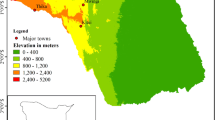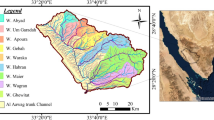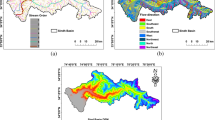Abstract
The present study focused on developing the predominant relationships between morphological and morphological-hydrological parameters of watersheds in the Makkah Al-Mukarramah region, Kingdom of Saudi Arabia (KSA). These relationships are essential for flood mitigation studies in the region. The relationships developed in this study are averaged over 43 watersheds (varying in size from 42.2 to 6081.4 km2) to provide a theoretical basis for regional morphological and hydrological analyses. In addition, the similarity of the hydrologic response of these watersheds is studied via the theory of geomorphological instantaneous unit hydrograph (GIUH). The results show that there is a relatively high similarity among the 43 basins (the average similarity parameter is 0.61, and the values vary from 0.57 to 0.68 at 95% confidence). Comparisons of the peaking factor between the Soil Conservation Service (SCS) and the Arid-Zone, Ari-Zo, (Albishi et al., Arabian Journal of Geosciences 10:1–13, 2017) models show that the common SCS model underestimates the peak discharge. The time of concentration is overpredicted by the Kirpich (Civil Engineering 10:362, 1940) equation (up to 17 times) compared to the Ari-Zo model. The GIUH and SCS models overestimate the time to peak when compared with the Ari-Zo model. These results are crucial for flood estimation and mitigation in the region.










Similar content being viewed by others
References
Abdulrazzak M, Al-Shabani A, Noor K, Elfeki A, Kamis A (2017) Integrating hydrological and hydraulic modelling for flood risk management in a high resolution urbanized area: case study Taibah University campus, KSA. pp. 827-829, Springer.
Abdulrazzak M, Elfeki A, Kamis AS, Kassab M, Alamri N, Noor K, Chaabani A (2018a) The impact of rainfall distribution patterns on hydrological and hydraulic response in arid regions: case study medina, Saudi Arabia. Arab J Geosci 11(21)
Abdulrazzak M, Al-Shabani A, Noor K, Elfeki A, Kamis A (2018b) Integrating hydrological and hydraulic modelling for flood risk management in a high resolution urbanized area: case study Taibah University campus, KSA. In: Kallel A, Ksibi M, Ben Dhia H, Khélifi N (eds) Recent advances in environmental science from the Euro-Mediterranean and surrounding regions. EMCEI 2017. Advances in Science, Technology & Innovation (IEREK Interdisciplinary Series for Sustainable Development), Springer, Cham
Albishi M, Bahrawi J, Elfeki A (2017) Empirical equations for flood analysis in arid zones: the Ari-Zo model. Arab J Geosci 10(3):1–13. https://doi.org/10.1007/s12517-017-2832-4
Al-Subyani AM, Bayumi TH (2001) Physiographical and hydrological analysis of Yalamlam basin, Makkah al-Mukarramah area. Earth Sci 13:1
Al-Wagdany A, Elfeki A, Kamis AS, Bamufleh S, Chaabani A (2020) Effect of the stream extraction threshold on the morphological characteristics of arid basins, fractal dimensions, and the hydrologic response. J Afr Earth Sci 172:103968. https://doi.org/10.1016/j.jafrearsci.2020.103968
Anyadike RNC, Phil-Eze PO (1989) Runoff response to basin parameters in southeastern Nigeria. Geografiska Annaler, Series A 71A:75–84
Azeez O, Elfeki A, Kamis A, Chaabani A (2020) Dam break analysis and flood disaster simulation in arid urban environment: the Um Al-Khair dam case study, Jeddah. Saudi Arabia Natural Hazards 100:995–1011. https://doi.org/10.1007/s11069-019-03836-5
Brown GF, Jackson RO (1960) The Arabian Shield: International Geological Congress 21st. Copenhagen, 1960, Proceedings, pt. 9, p. 67-77
Dingman SL (1978) Synthesis of flow-duration curves for unregulated streams in New Hampshire. Water Resour Res 14:1481–1502. https://doi.org/10.1111/j.1752-1688.1978.tb02298.x
Elfeki A, Bahrawi J (2017) Application of the random walk theory for simulation of flood hazards: Jeddah flood 25 November 2009. Int J Emerg Manag 13(2):169–182.1471-4825
Elfeki AM, Ewea HAR, Bahrawi JA, Al-Amri NS (2014) Incorporating transmission losses in flash flood routing in ephemeral streams by using the three-parameter Muskingum method. Arab J Geosci 8:5153–5165. https://doi.org/10.1007/s12517-014-1511-y
Ewea H, Elfeki AM, Bahrawi JA, Al-Amri N (2016) Sensitivity analysis of runoff hydrographs due to temporal rainfall patterns in Makkah Al-Mukkramah region, Saudi Arabia. Arab J Geosci 9:424. https://doi.org/10.1007/s12517-016-2443-5
Farran MM, Elfeki AM (2020a) Statistical analysis of NRCS curve number (NRCS-CN) in arid basins based on historical data. Arab J Geosci 13:31. https://doi.org/10.1007/s12517-019-4993-9
Farran MM, Elfeki AM (2020b) Variability of the asymptotic curve number in mountainous undeveloped arid basins based on historical data: case study in Saudi Arabia. Journal of African Earth Sciences 162:103697. https://doi.org/10.1016/j.jafrearsci.2019.103697
Farran MM, Elfeki AM (2020c) Evaluation and validity of the antecedent moisture condition (AMC) of Natural Resources Conservation Service-Curve Number (NRCS-CN) procedure in undeveloped arid basins. Arab J Geosci 13:275. https://doi.org/10.1007/s12517-020-5242-y
Farran MM, Elfeki AM, Elhag M, Chaabani A, (2021). A comparative study of the estimation methods for NRCS curve number of natural arid basins and the impact on flash flood predictions. Arabian Journal of Geosciences, (To appear)
Hall MJ, Zaki AF, Shahin MMA (2001) Regional analysis using the geomorphoclimatic instantaneous unit hydrograph. Hydrol Earth Syst Sci 5(1):93–102
Horton RE (1932) Drainage basin characteristics. Trans Am Geophys Union 13:350–361
Horton RE (1945) Erosional development of streams and their drainage basins. Hydrophysical approach to quantitative morphology. Geol Soc Am Bull 56:275–370
Jolly JP (1982) A proposed method for accurately calculating sediment yields from reservoir deposition volumes. In: Recent developments in the explanation and prediction of erosion and sediment yield. Proceedings of Exeter Symposium, July. IAHS Publ 137:153–161
Kirchner JW (1993) Statistical inevitability of Horton’s laws and the apparent randomness of stream channel networks. Geology 21(7):591–594
Kirpich ZP (1940) Time of concentration of small agricultural watersheds. Civ Eng 10(6):362
Leopold LB, Wolman MG (1957) River channel patterns braided, meandering, and straight. US Geol Survey Prof Paper 282-B:85
Marko K, Elfeki A, Alamri N, Chaabani A. (2019). Two dimensional flood inundation modelling in urban areas using WMS, HEC-RAS and GIS (case study in Jeddah City, Saudi Arabia): IEREK Interdisciplinary Series for Sustainable Development. Advances in Remote Sensing and Geo Informatics Applications, 01/2019: pages 265–267
Masoud M (2016) Geoinformatics application for assessing the morphometric characteristics' effect on hydrological response at watershed (case study of Wadi Qanunah, Saudi Arabia). Arab J Geosci 9:280. https://doi.org/10.1007/s12517-015-2300-y
McCuen RH (1989) Hydrologic analysis and design. Prentice-Hall, Englewood Cliffs, NJ
Menteş E, Kaya Ş, Tanık A, Gazioğlu C (2019) Calculation of flood risk index for Yesilirmak Basin-Turkey. International Journal of Environment and Geoinformatics 6(3):288–299. https://doi.org/10.30897/ijegeo.661533 (https://dergipark.org.tr/tr/download/article-file/892427)
Ministry of Environment, Water, and Agriculture (2015). http://app.mowe.gov.sa/Daily Rains News/Rain_Dams.aspx. Accessed 29 May 2018
Nash JE (1957) The form of the instantaneous unit hydrograph. Int Assoc Sci Hydrol Publ 45(3):114–121
Nash JE (1958) Determining runoff from rainfall. Proc Inst Civ Eng 10:163–184
Nash JE (1959) Systematic determination of unit hydrograph parameters. J Geophys Res 64(1):111–115
Nash JE (1960) A unit hydrograph study, with particular reference to British catchments. Proc Inst Civ Eng 17:249–282
Niyazi B, Khan A, Masoud M, Elfeki A, Basahi J (2020) Variability of the geomorphometric characteristic of Makkah al Mukarromah basins in Saudi Arabia and the impact on the hydrologic response. Journal of Earth African Science 168:103842
Rodríguez-Iturbe I, Valdés JB (1979) The geomorphologic structure of hydrologic response. Water Resour Res 15(6):1409–1420
Rodríguez-Iturbe I, González-Sanabria M, Bras RL (1982a) A geomorphoclimatic theory of the instantaneous unit hydrograph. Water Resour Res 18(4):877–886
Rodríguez-Iturbe I, González-Sanabria M, Bras RL (1982b) On the climate dependence of the IUH: a rainfall-runoff analysis of the Nash model and the geomorphoclimatic theory. Water Resour Res 18(4):887–903
Rosso R (1984) Nash model relation to Horton order ratios. Water Resour Res 20(7):914–920
Sathymoorthy DR, Palanikumar B, Sagar SD (2007) Morphological segmentation of physiographic features from DEM. Int J Remote Sens 28(15):3379–3394
Strahler AN (1952) Hypsometric analysis of erosional topography. Bull Geol Soc Am 63:1117–1142
Strahler AN (1953) Revision of Horons’ quantitative factors in erosional terrain. Trans Am Geophys U 34:356
Subyani AM (2011) Hydrologic behavior and flood probability for selected arid basins in Makkah area, western Saudi Arabia. Arab J Geosci 4(5-6):817–824
Taylor AB, Schwarz HE (1952) Unit hydrograph lag and peak flow related to basin characteristics. Trans Am Geophys Union 33:235–246
USDA-SCS (1985) National engineering handbook section 4: hydrology, soil conservation service. USDA, Washington, DC
Viessman W, Knapp JW, Lewis GW, Harbaugh TE (1977) Introduction to hydrology. Harper and Row, New York
Ward RC, Robinson M (2000) Principles of hydrology, 4th edn. McGraw-Hill, Maidenhead
Acknowledgements
The authors thank the DSR for the technical and financial support.
Funding
This article presents a part of the results of a project funded by the Deanship of Scientific Research (DSR) at King Abdulaziz University, Jeddah, under grant no. RG-1-123-39.
Author information
Authors and Affiliations
Corresponding author
Ethics declarations
Conflict of interest
The author(s) declare that they have no competing interests.
Additional information
Responsible Editor: Amjad Kallel
Rights and permissions
About this article
Cite this article
Niyazi, B., Khan, A.A., Masoud, M. et al. Morphological-hydrological relationships and the geomorphological instantaneous unit hydrograph of Makkah Al-Mukarramah watersheds. Arab J Geosci 14, 751 (2021). https://doi.org/10.1007/s12517-021-07063-w
Received:
Accepted:
Published:
DOI: https://doi.org/10.1007/s12517-021-07063-w




